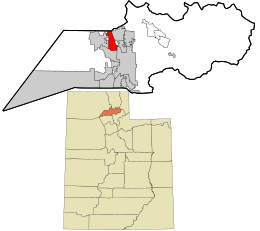Farr West, Utah
| Farr West, Utah | |
|---|---|
| City | |
 Location in Weber County and the state of Utah |
|
| Coordinates: 41°17′35″N 112°1′35″W / 41.29306°N 112.02639°WCoordinates: 41°17′35″N 112°1′35″W / 41.29306°N 112.02639°W | |
| Country | United States |
| State | Utah |
| County | Weber |
| Settled | 1858 |
| Incorporated | 1981 |
| Founded by | Joseph Taylor |
| Named for | Lorin Farr and Chauncey W. West |
| Area | |
| • Total | 5.8 sq mi (15.1 km2) |
| • Land | 5.8 sq mi (15.1 km2) |
| • Water | 0.0 sq mi (0.0 km2) |
| Elevation | 4,265 ft (1,300 m) |
| Population (2012) | |
| • Total | 6,122 |
| • Density | 530.0/sq mi (204.6/km2) |
| Time zone | Mountain (MST) (UTC-7) |
| • Summer (DST) | MDT (UTC-6) |
| ZIP code | 84404 |
| Area code(s) | 385, 801 |
| FIPS code | 49-24850 |
| GNIS feature ID | 1441012 |
| Website | http://farrwestcity.net/ |
Farr West is a city in Weber County, Utah, United States. The population was 3,094 at the 2000 census. It is part of the Ogden–Clearfield, Utah Metropolitan Statistical Area.
According to the United States Census Bureau, the city has a total area of 5.8 square miles (15.1 km²), all of it land.
Farr West is bordered by Plain City to the west, Willard to the north, Pleasant View to the north east, Harrisville to the east, and Marriott-Slaterville to the south.
Farr West City is located on the north end of Weber County. It is bordered on the east by Pleasant View and by Harrisville, on the south by Slaterville, and on the west by Plain City, and was first settled by Mormon pioneers. In 1858 Joseph Taylor settled in the area that later became Farr West. In 1868 the area was included as a part of Harrisville when a precinct was organized. On 30 November 1890 western Harrisville was organized into a separate LDS ward and given the name Farr West in honor of Lorin Farr, former president of the Weber LDS stake, and Chauncey W. West, who had served as presiding bishop of Weber County, and who was the son-in-law of Abraham Hoagland. The name echoes "Far West", an important early Mormon settlement in frontier Missouri.
The earliest settlers engaged in agriculture for their livelihood, and it received a great boost when the sugar beet industry was introduced in 1898. In 1923 further benefits were available to farmers when the Utah Packing Corporation installed a pea viner to help process field-grown peas.
...
Wikipedia
